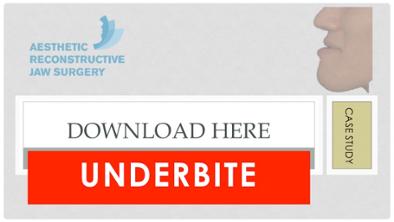Share this
Underbite – upper jaw surgery or lower jaw surgery or both?
on May 3, 2016

A protruding lower jaw is a fairly common facial deformity in Singapore. While it may not be the most common, it is one which for which surgical correction is most sought after.
Underbite, as it is commonly called by many patients, poses significant functional challenges, depending on the degree of deformity. When the lower jaw grows disproportionately more than the upper jaw, the lower teeth are brought forward and causing an open bite.
This disproportionate growth also cause the facial profile to resemble what some people call the “shoe horn”. Many patients coming for consultation usually assume that the problem can be solved by surgery to set the lower jaw back. However, in reality, most patients actually need something else.
Underbite Jaw Surgery
The bite of an underbite deformity can be corrected by surgery to set the lower jaw back alone. However, such single jaw surgery may create a different deformity or a different functional problem.
Sometimes, the main cause of an underbite may not be an excessively long lower jaw. It may be due to an underdeveloped upper jaw. As such, a thorough assessment of the facial dimensions is critical to establishing the proper diagnosis.
If the problem lies with the upper jaw, then surgery to advance the upper jaw is the correct thing to do. If the lower jaw is set back instead, it will result in a very retruded lower jaw which not only make the face appear very flat but may cause obstructive sleep apnea.
Obstructive sleep apnea
Obstructive sleep apnea is a condition whereby breathing during sleep is obstructed due to tissues in the airway from the nose to the throat blocking the flow of air. Repositioning the lower jaw too far back reduces the space for the tongue, pushing it into the throat. During sleep, the tongue in its relaxed state falls backwards and blocks the flow of air downwards into the lungs. Obstructive sleep apnea may give rise to long term medical problems such as hypertension and heart failure due to the excessive work that the heart needs to do to compensate for the lack of breathing.
The flat face effect caused by wrong surgery is also detrimental to the patient’s psyche. Even if the patient is not seeking jaw surgery for cosmetic reasons, replacing one facial deformity with another can be most disappointing.
The converse can be true as well. If the problem truly lies with the lower jaw being too long, advancing the upper jaw forward to achieve a proper bite will create an unaesthetic result too.
An upper jaw that is repositioned too far forward will give an ape-like appearance. Granted, this will not cause obstructive sleep apnea but another functional problem, velopharyngeal incompetence, can arise. This is due to the soft palate being brought too far forward from the throat when the upper jaw is advanced.
Patients with cleft palate often have this problem. In its normal position, the soft palate is responsible for separating the oral part of the throat from the nasal part. When the soft palate, which is made up of muscles, contracts, it comes into contact with the back wall of the throat, thereby creating a separation of the nose and mouth. This prevents drinks and food from being regurgitated up the nose when we eat. It is also responsible for speech.
If the upper jaw is brought too far forward to correct the bite to the extent that the soft palate is unable to contact the back wall of the throat, food and drinks may get into the nose during meals and some words cannot be pronounced properly in addition to a very nasal speaking tone.
In reality, the majority of cases are not simple single jaw growth anomalies. There is always a bit of both i.e. the lower jaw is long and the upper jaw is short. Doing a single jaw surgery, whether upper or lower, will bring about compromises both functionally as well as aesthetically. Patients presenting for surgical correction of underbite are young and usually parental consent is needed. Parents are usually concern about the morbidity of surgery and would like to have as simple a surgery as possible, and rightfully so.
However, if a simpler surgery that does not achieve the objective is definitely more invasive than a less simple surgery that does. Worse, if in the process of solving one problem, we may create new problem.
Some patients or parents may claim that their aesthetics is not important and that all they want is a functional correction. However, in this day and age, I do not believe that any patient will want to change from a long face to a flat face. As such, if the patient only wants a single jaw surgery when a double jaw procedure is needed, I will not proceed with the surgery.
Very often, patients are not able to visualize the final outcome even with the help of simulation software. By the time the postoperative swelling subsides and they see themselves in the mirror, it will be quite difficult to change.
The objective of corrective jaw surgery is to correct the bite and harmonize the facial appearance while maintaining a proper airway for breathing, mastication and speech. A good plan should aim to achieve all of the above and sometimes, a double jaw surgery is needed while at other times, a single jaw surgery may suffice.
Good Candidates for Underbite Surgery
You are considered a good candidate for underbite surgery if you have:
- Severe Underbite. Underbite surgery is typically reserved for patients with a severe underbite that cannot be corrected with orthodontic treatment alone. Good candidates for underbite surgery usually have a significant discrepancy between the upper and lower jaws, with the lower jaw protruding forward.
- Good Oral Health. Underbite surgery is a surgical procedure that involves making incisions in the jawbone and repositioning the jaw. Good candidates for underbite surgery should have good oral health and be free of any dental problems that may affect the outcome of the procedure.
- Good Overall Health. Like any surgical procedure, underbite surgery carries certain risks and potential complications. Good candidates for underbite surgery should be in good overall health and free of any medical conditions that may increase the risk of complications.
- Realistic Expectations. Good candidates for underbite surgery should have realistic expectations about the outcome of the procedure. While underbite surgery can provide significant improvements in the appearance and function of the jaw, it is not a cure-all for all dental and cosmetic concerns.
- Non-Smokers. Smoking can increase the risk of complications during and after surgery. Good candidates for underbite surgery should be non-smokers or willing to quit smoking for a certain period of time before and after the procedure.
- Adequate Bone Structure. Underbite surgery requires adequate bone structure to support the jaw and achieve a natural-looking result. Good candidates for underbite surgery usually have enough bone structure to support the jaw and achieve the desired outcome.
- Commitment to Postoperative Care. Underbite surgery requires a significant commitment to postoperative care, including a liquid or soft food diet for several weeks and careful oral hygiene. Good candidates for underbite surgery should be willing to follow their surgeon's postoperative instructions to minimize the risk of complications and ensure proper healing.
Benefits of Underbite Surgery
Some of the benefits of underbite surgery include:
- Improved Appearance. One of the most significant benefits of underbite surgery is the improvement in the appearance of the face and jaw. Underbite surgery can correct the position of the lower jaw, creating a more balanced and symmetrical facial profile.
- Improved Function. Underbite surgery can also improve the function of the jaw, allowing for proper alignment of the teeth and improved chewing and speech.
- Reduced Jaw Pain. Severe underbite can cause jaw pain and discomfort. Underbite surgery can alleviate these symptoms by correcting the position of the jaw and reducing the strain on the jaw muscles.
- Improved Breathing. In some cases, underbite surgery can improve breathing by increasing the size of the airway and reducing the risk of sleep apnea.
- Improved Oral Health. Underbite surgery can also improve oral health by correcting the alignment of the teeth and reducing the risk of dental problems such as tooth decay and gum disease.
- Improved Self-Confidence. Underbite surgery can have a significant impact on a patient's self-confidence and self-esteem. By improving the appearance of the face and jaw, underbite surgery can help patients feel more confident and comfortable in social situations.
- Long-Term Results. Underbite surgery provides long-term results that can last a lifetime with proper care and maintenance.
Underbite surgery can provide significant benefits for patients with a severe underbite that cannot be corrected with orthodontic treatment alone. Patients considering underbite surgery should discuss their goals and expectations with their oral surgeon and carefully consider the potential risks and benefits of the procedure before deciding to undergo surgery.
Possible Risks and Complications of Underbite Surgery
Below are some of the most common risks and complications associated with underbite surgery:
- Infection. Like any surgical procedure, infection is a potential risk of underbite surgery. While the risk of infection is relatively low, it can occur and can be prevented with proper surgical techniques and postoperative care.
- Nerve Damage. Underbite surgery involves making incisions in the jawbone and repositioning the jaw, which can damage the nerves in the area. This can lead to numbness or tingling in the jaw, lower lip, or tongue. While these symptoms are usually temporary and resolve on their own within a few weeks or months, in rare cases, they can be permanent.
- Implant Displacement. In some cases, underbite surgery involves the use of implants to support the jawbone. While these implants are designed to stay in place, there is a risk of displacement, especially in the first few weeks after surgery. If the implant shifts or moves, it may need to be repositioned or removed, which can require additional surgery.
- Scarring. Underbite surgery involves making incisions in the jawbone, which can result in visible scarring. While plastic surgeons use techniques to minimize scarring, some scarring is unavoidable, and the extent of scarring can vary depending on the patient's skin type and healing ability.
- Unsatisfactory Results. While underbite surgery can provide significant improvements in the appearance and function of the jaw, there is always a risk that the patient may not be satisfied with the results. In some cases, additional surgery may be required to achieve the desired outcome.
- Allergic Reaction. In rare cases, patients may have an allergic reaction to the implant material used in underbite surgery. Patients should inform their oral surgeon of any allergies they have before the procedure.
- Hematoma. Hematoma is a potential risk of any surgical procedure and involves the accumulation of blood under the skin. While the risk of hematoma is relatively low, it can occur and may require additional surgery to drain the blood.
Aftercare Tips for Underbite Surgery
After the surgery, it is important to follow proper aftercare instructions to ensure proper healing and minimize the risk of complications. Below are some aftercare tips for underbite surgery:
- Follow Your Surgeon's Instructions. Your oral surgeon will provide specific instructions for aftercare, including how to care for the incision site, medications to take, and when to return for follow-up appointments. It is important to follow these instructions carefully to ensure proper healing.
- Rest and Limit Physical Activity. After the surgery, it is important to rest and limit physical activity for several days. Avoid strenuous activities, lifting heavy objects, and bending over.
- Apply Ice Packs. Applying ice packs to the face can help reduce swelling and discomfort after the surgery. Use ice packs for 20 minutes at a time, several times a day.
- Eat a Soft Diet. After the surgery, it is important to eat a soft diet for several weeks. Avoid hard, crunchy, or chewy foods that can put strain on the jaw. Stick to soft foods like soups, mashed potatoes, and scrambled eggs.
- Practice Good Oral Hygiene. It is important to practice good oral hygiene after underbite surgery. Brush your teeth gently and rinse your mouth with warm salt water several times a day to keep the incision site clean.
- Take Pain Medication as Prescribed. Your oral surgeon may prescribe pain medication to manage any discomfort after the surgery. Take the medication as prescribed and do not exceed the recommended dosage.
- Attend Follow-Up Appointments. It is important to attend all follow-up appointments with your oral surgeon to monitor your progress and ensure proper healing.
- Avoid Smoking. Smoking can delay healing and increase the risk of complications after underbite surgery. Avoid smoking for several weeks before and after the surgery.
- Be Patient. It can take several weeks or months for the full results of underbite surgery to be visible. Be patient and follow your surgeon's instructions for aftercare to ensure the best possible outcome.
Frequently Asked Questions
The surgery takes about 3-4 hours if both upper and lower jaws need to be corrected. For single jaw surgery, it takes about 1-2 hours.
Mild degrees of underbite can be camouflaged with orthodontics. Orthodontics can compensate for the skeletal discrepancy by moving the teeth into a better functional occlusion but the facial appearance will remain the same.
There is no scarring on the face as all incisions are made inside the mouth. However, scars on the gums may be visible, but only to the patient.
After a month, most patients are able to return to normal activities except for contact sports. Contact sports are best avoided for at least six months after surgery.
You will need to stick with a soft diet for the first 2-3 weeks after surgery and move progressively to a normal diet after one month. Routine physical activities such as walks are recommended but strenuous activities such as running and swimming should be avoided until about a month post surgery. Contact sports should be avoided for six months.
In mild cases, camouflage orthodontics can be done to improve the bite. However, this will not change the facial appearance. If the patient’s treatment objectives include improvement in facial appearance, there is no alternative to surgery.
Choosing the right surgeon is the most important step. Seek a second opinion if necessary. Ensure that there is a common understanding between you and the surgeon as to what your desired outcome is. A perfectly executed surgery will not be considered successful if the outcome is not what you had in mind when going for the surgery.
Results done in full grown adults are permanent. However, surgery is often done during late teens and early twenties because that is when most patients are socially conscious of their condition. If they have residual growth still ongoing after the surgery, there may be relapse of the underbite due to continuing growth of the lower jaw after the surgery.
Share this
- Jaw Surgery (93)
- Dental Implants Singapore (90)
- Orthognathic Surgery (48)
- Replacing Missing Teeth (26)
- Missing Teeth Options (23)
- Underbite (23)
- Bone Grafting (21)
- Costs (18)
- Facial Aesthetics (18)
- Aesthetics (17)
- dental implants (16)
- corrective jaw surgery (15)
- BOTOX (11)
- Dermal Fillers (11)
- Wisdom teeth (10)
- Fixed Implant Dentures (8)
- Loose Dentures Singapore (6)
- Medisave (6)
- sleep apnea (6)
- Braces (5)
- Dental Pain (5)
- Dentures in Singapore (5)
- Loose Teeth (5)
- Tooth Extraction (5)
- jaw deformities (5)
- bimax (4)
- bone graft (4)
- maxillomandibular advancement (4)
- all-on-4 (3)
- bimaxillary protrusion (3)
- chin implant (3)
- facial asymmetry (3)
- full mouth dental implants (3)
- genioplasty (3)
- immediate implant (3)
- removal of an integrated dental implant (3)
- third molars (3)
- wisdom tooth surgery (3)
- My Dentures Don't Fit (2)
- VME (2)
- bone graft healing (2)
- distraction osteogenesis (2)
- medical tourism (2)
- obstructive sleep apnea (2)
- orthodontics (2)
- plastic surgery (2)
- CT guided dental implants (1)
- Double jaw surgery (1)
- Invisalign (1)
- Periodontal Disease (1)
- Permanent Dentures Singapore (1)
- before and after photos (1)
- facial trauma (1)
- fractured dental implant (1)
- oral appliance therapy (1)
- root canal treatment (1)
- veneers (1)
- vertical maxillary excess (1)
- September 2019 (2)
- July 2019 (2)
- May 2019 (2)
- August 2018 (1)
- October 2017 (1)
- September 2017 (2)
- August 2017 (1)
- June 2017 (2)
- May 2017 (4)
- April 2017 (1)
- March 2017 (1)
- February 2017 (3)
- January 2017 (3)
- December 2016 (1)
- November 2016 (2)
- October 2016 (4)
- September 2016 (9)
- August 2016 (5)
- July 2016 (11)
- June 2016 (14)
- May 2016 (6)
- April 2016 (2)
- March 2016 (1)
- January 2016 (7)
- December 2015 (10)
- November 2015 (4)
- October 2015 (9)
- September 2015 (7)
- August 2015 (1)
- July 2015 (6)
- June 2015 (3)
- May 2015 (7)
- April 2015 (5)
- March 2015 (8)
- January 2015 (5)
- December 2014 (7)
- November 2014 (7)
- October 2014 (6)
- September 2014 (8)
- August 2014 (5)
- July 2014 (7)
- June 2014 (8)
- May 2014 (9)
- April 2014 (10)
- March 2014 (6)
- February 2014 (8)
- January 2014 (3)
Subscribe by email
Email subscription





Comments (1)